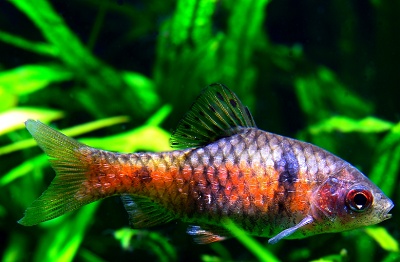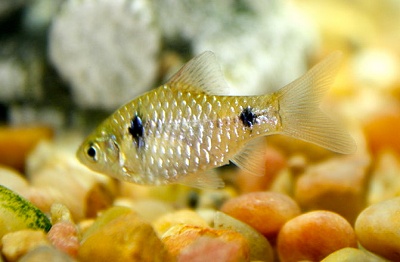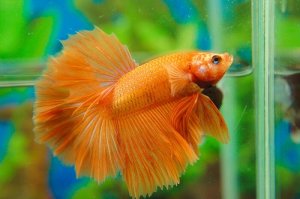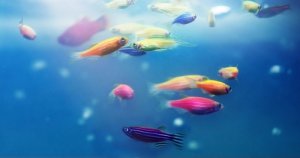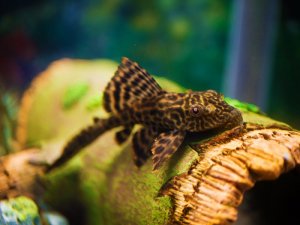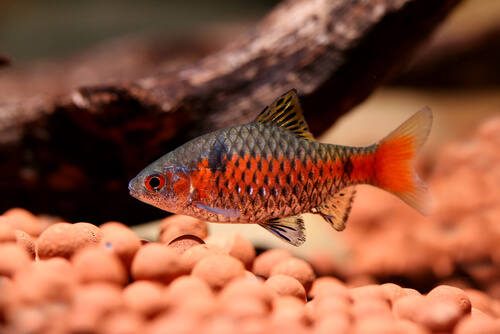
The Odessa barb species is a smaller specimen of the barb species, that is a peaceful communal fish. What makes the Odessa barb so special is its bold and bright coloring and intricate markings. It is an easy Freshwater fish to keep that requires minimal effort, and that enjoys colder water, thus you may be able to get away without having to use a heater.
They are active fish that will ensure you many hours of viewing pleasure with their fun antics and quirks. The Odessa barb is one of the most colorful smaller barb species to keep, especially during their spawning season, and they are perfect for beginners. So, here are a few facts on them, and an easy guide to help you care for your Odessa barb.
Breed Overview
| Origin | South and Southeast Asia. |
| Lifespan | 3 – 5 years. |
| Size | Usually 4.6 cm (1.8 inches) in size, but can reach up to 7 cm (2.8 inches) in size. |
| Colors | Rosy barb, Black Ruby Barb, and Ticto barb are of the same genus. |
| Food | Omnivore, enjoys a varied diet. |
| Tank Size | At least 30 Gallons, though 50 gallons for more than five fish is advised. |
| Temperament | Peaceful and Active, Communal. |
| Water Type | Fresh and Colder water. |
| Water Temperature | Around 64.5 – 71.5° F (14 – 22° C). |
| Water pH | Slightly acidic between 6.5 pH and 8.0pH. |
| Difficulty Level | Relatively Easy. |
Odessa Barb Fish Species Summary
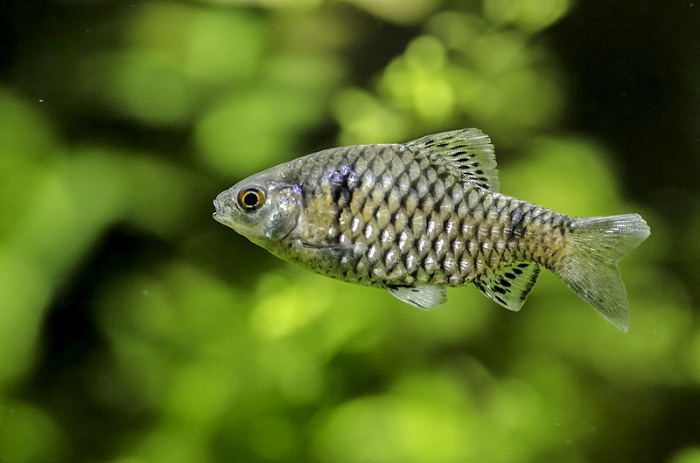
The Odessa barb is an Ornamental Freshwater fish species that is part of the Cyprinidae family, scientifically known as a “Pethia Padamya”. The genus called “Pethia” refers to the smaller-sized barbs found in Southeast, and South Asia, whereas “Padamya” refers to the ruby-like color markings of the male, which is similar to the Ruby Barb.
It is originally found in Asia in Central Myanmar, mostly in ponds above the Anisakan Falls, and some from the Chindwin River.
The Odessa Barb often gets confused with the Ticto Barb, which looks similar though, lacking the lustrous colors of the Odessa Barb. In 2008 pet fish enthusiasts and aquarists in Odessa Ukraine, first encountered and scientifically described the fish, thus naming it after the town Odessa.
Color Variations Found In Odessa Barbs
Regarding the Odessa Barb, there is only one color variation for the specific species, though in the “Pethia” genus there are quite a few color variations of the smaller barbs.
The male and female Odessa Barb fish differ slightly from each other in colors and markings;
| Male Odessa Barb
|
Female Odessa Barb
|
| The Male typically has a beige to light brown base color, with a prominent bright red stripe that runs along the length of the body. You may note that the male has red irises and a narrow black streak in the middle of his eye. The males feature fins that are more clear in color with a slight yellow/green tinge, and there are contrasting black flecks on the fins, with a black stripe on the edges of the fins except for the tail fin.
A large black spot is marked on the dorsal area of the body and the tail area, similar to the female. During spawning conditions, the male will become a darker almost black color with an intensified red lateral stripe. |
Unlike the male, the female has a plainer beige color with shimmering, silvery scales. She likewise shows the black spot near the gills and on the tail area. Females have yellowish-green caudal, pectoral, and dorsal fins with black stripes, comparable to that of the male, only reflecting on the dorsal fins.
As you can see the female is much more plain in color than the more vibrant male, though she will likewise darken in color during Spawning. |
Some other color varieties un the smaller Barb Fish species include;
- The Rosy Barb – Pethia Conchonius, is a more solid colored fish where the male is a brighter red color with a black tip on the dorsal fin. The females are more of a silvery, or gold color. There is a prominent black dot on the caudal area.
- The Black Ruby Barb – Pethia Nigrofasciata is one of the most colorful Barb species with dark red Ruby males that are almost black towards the tail and females with 3 bold vertical stripes comparable to Tiger Barbs.
- The Ticto Barb – Pethia Ticto, also known as the Two Spot Barb fish, is silver and gold in color, with a black spot on the pectoral area, and near the tail on the body.
Odessa Barb Size
As you have noted, the Odessa Barb is a smaller species of Barb that has a “laterally compressed body”. According to measurements done among 28 adults Odessa Barb fish, the results described both males and females to reach an average of 4.6 cm (1.8 inches) in size, and some specimens to reach up to 7 cm (2.8 inches) in size.
Temperament And Behaviour Of The Odessa Barb
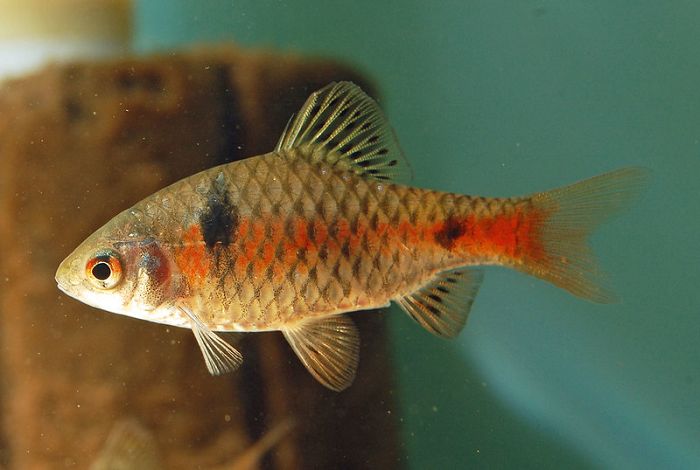
Compared to most smaller Barb Fish species, the Odessa Barb is a peaceful and very active fish that needs to be kept in a community. It is crucial to keep Odessa Barbs in groups of talents 5 or more fish, as they can become aggressive towards other tank mates when they are less or on their own.
Generally, they enjoy a large community tank with plenty of open space to swim, and they are avid jumpers, so be sure to invest in a secure lid for your aquarium. That said, let’s carry on to setting up a tank and caring for your Odessa Barb;
General Care
Odessa Barb fish live in the still areas of rivers and streams in their natural habitat, as I have mentioned they will need open spaces for swimming and a hiding space. They are accustomed to colder water temperatures, so you may get away with an unheated tank. Odessa Barb are Omnivores with a substantial appetite, and they require a variety of foods, so you need to be prepared for this fact.
However, firstly let us start with creating a healthy and suitable living environment for your Odessa barbs, hence, they are Shoaling fish so you will need to purchase at least five of them, and can add a few other appropriate species as tank mates.
Creating The Perfect Home For Your Odessa Barb
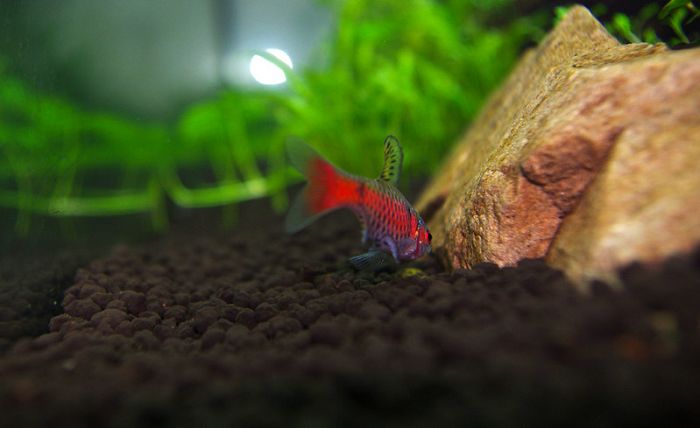
Odessa Barb favors being in schools, they are lively swimmers, requiring a larger tank, with plenty of plantation, and open space in the center for swimming.
They do well in colder water that is soft, and slightly acidic. They are active, fast-moving, and generally peaceful when kept in groups, and as I have cited, they are excellent jumpers, so ensure that your tank has a reliable lid. That said, let’s go into the details of setting up your tank;
What Size Tank Do Odessa Barb Fish Need
Odessa fish kept in groups of five or more will need a tank that is around 30 gallons (115 Litres), though a 50-gallon tank will be more suitable should you want to add other small species as companions.
Water Conditions
- Temperature – Odessa Barbs prefer colder water temperatures of around 64.5 – 71.5° F (14 – 22° C). Keep in mind when you have other species as tank mates, that they may require slightly higher temperatures.
- Lighting – You may not need additional light as Odessa Barbs prefer dim light, that is low to moderate, and they should be placed in an area, out of direct sunlight.
- Filtration – Because the currents in their natural habit are relatively strong, they enjoy low to moderate currents in filtration systems. An under-gravel, or adjustable Current filtration system is one of the best options for Odessa Barb as it additionally oxygenates the water.
- pH Levels – Odessa Barb are relatively adaptable with pH levels, and you can keep them in a slightly acidic pH range of around 6.5-8.0.
- Water Hardness – They prefer softer water if around 5-12dH.
Decorating Your Tank
One of the favorite parts of creating an aquarium home for your fish is of course the decorations, which should be considered thoroughly regarding Odessa barbs.
Because of their lively native, you should not overcrowd their tank with extravagant decorations but rather stick to more natural décor and plants. They enjoy plenty of vegetation since there are found in streams and rivers.
1. Substrate
More natural and darker-colored substrates will be safe for your Odessa barb and will bring out their exquisite colors. Aquarium soils, sand, and gravel are your best options. You can similarly add a few larger pebbles as decoration.
2. Synthetic Plants
Soft fabric or silk synthetic plants will make a good addition to your tank, and they produce less waste, though they need to be cleaned, and do not have much to offer in terms of keeping the tank clean.
3. Live Plants
As I myself prefer a more natural-looking aquarium similar to their natural habit, I usually advise using live plants rather than synthetic plants. Live plants have their benefits, they help to keep the tank clean and oxygenate the water. Live plants are also a food source for many of the tank habitats. Though there is more cleaning with live plants, as you need to remove the dead leaves.
Odessa barb, being omnivores will most likely enjoy snacking on some of the live plants in their tank.
Odessa barbs enjoy floating, and planted live plants, here are a few plant choices you can consider;
- Floating Plants – Floating Plants such as Dwarf Lettuce, Subwassertang, Crystalworth Riccai, Duckweed, Anacharis, Water Sprites, and Java Moss are excellent Floating Plants for Odessa Barb.
- Rooted Plants – Odessa barb love to hide in long stem rooted plants such as Amazon sword, Ambulias, Water Wisterias, and Hornwort and Primrose.
You can read more about Freshwater aquarium plants in Wikipedia, concentrate on species that will be suitable for the water conditions, and moderate to high currents in your Odessa Barb tank.
4. Ornaments
Regarding ornaments and hiding places, nothing too elaborate is needed. Odessa barbs will noticeably enjoy taking shelter in long-stem plants rather than fancy caves and castles. Though, you can add a few rocks, some driftwood as more natural décor, and maybe a cave for other tank mates to hide.
Introducing Your New Fish to Its Home
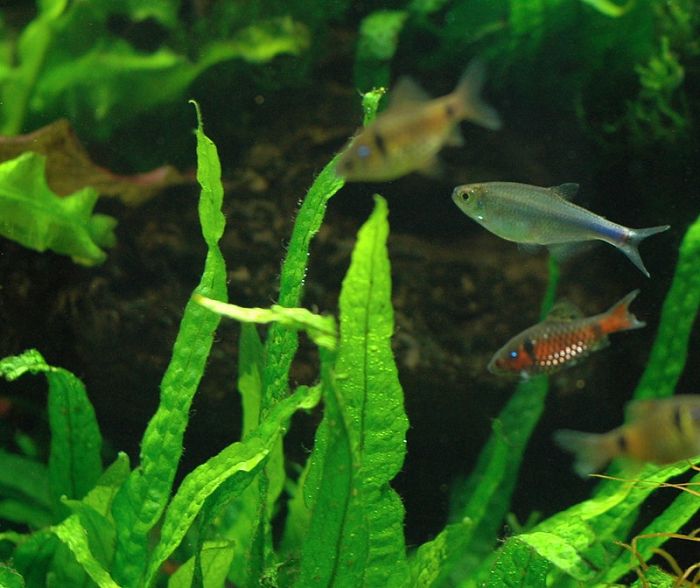
So, now that you have properly established your tank, cycled the water for a few days, and your tank is ready and at peak water conditions, it is time to add your new fish. You may have an already established tank with other species, in which case I would suggest that you feed them first before adding any new fish, to keep them calm and less aggressive.
Though, you will need to choose your Odessa Barbs first, and ensure that they are healthy;
How To Choose An Odessa Barb
It is crucial to your entire aquarium and inhabitants that you choose healthy newcomers. As established you will need at least five or more Odessa Barbs. Healthy fish will show the following signs;
- They will swim actively and have a symmetrical gait when swimming.
- They will eat enthusiastically when presented with food.
- Healthy fish will have bright and bold colors and no faded or patchy colorations.
- There will be no white spots or residue on the skin, or fins of the fish.
- The eyes need to be clear and dark in color for Odessa Barbs.
- The fins will have no damage or tears on them.
- The fish must not seem bloated or uncomfortable.
- Look for a fish that is not stressed and hiding away.
- Choose young Odessa barb, juveniles, but not babies or elderly fish.
Adding Your Fish To The Tank
Before placing your new fish inside their tank, it is crucial to ensure that the water temperature and conditions are perfect. You can do this with a thermometer and pH testing strips. Allow your fish to float in the bag on the surface of the water for around ten minutes to adjust to the temperature, then remove a cup of the water from the bag and replace it with a cup of water from the tank, and leave them for another ten minutes.
Repeat the steps until the bag is almost full with tank water only, and then you can release your fish into the tank. You can use a net to place them in the tank, as you want the least amount of water from the bag in your tank.
Selecting Other Species Companions
Odessa barb, if kept in groups, are peaceful schooling fish that will get along easily with tank mates that have similar temperaments, or that are just generally non-aggressive and not overly territorial.
I would recommend fish such as Plecos from the Hypancistrus family or Corydoras Catfish, which are small bottom feeders aiding in keeping your tank clean. Snails will likewise be a good addition for this purpose.
Other small schooling fish such as Tetras and Danios will add a splash of color to your tank, and should similarly be kept in groups.
For single or coupled fish Ram Cichlids are colorful and striking fish that have a peaceful nature in communal tanks taken where there is ample space.
Feeding Your Odessa Barbs
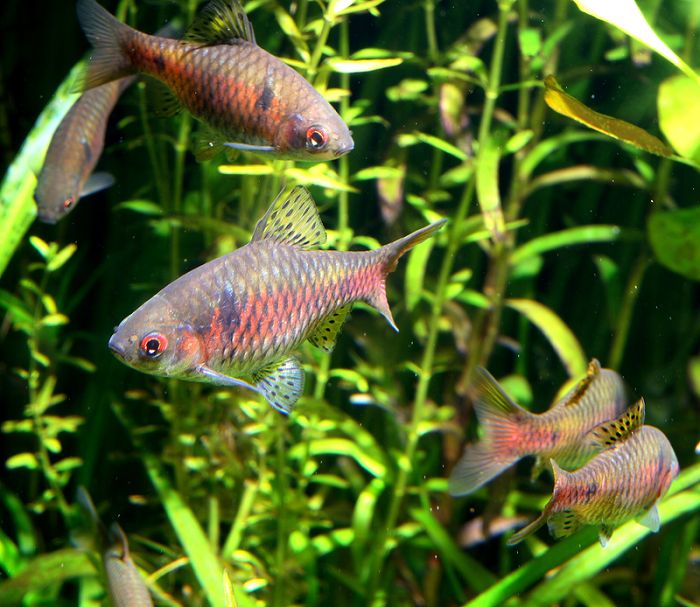
Odessa Barbs are ravenous eaters that are not fussy about food at all. They will easily feast on any type of food provided. They should however be provided with a more varied diet including;
Odessa Barb Foods
- Pellets – Small Quality Pellets soaked in water first.
- Flakes – High-quality flakes.
- Live and Frozen Foods – Freeze Dried or live foods such as daphnia, shrimps, blood worm, or minced beef heart. Only given as occasional snacks.
- Plant Material – Plant Based flakes or lettuce, spinach, and zucchini, thinly sliced, and blanched first.
How Much And When Should You Feed
Odessa Barb can be fed two to three times a day in small amounts, enough for them to finish within five minutes or so. Try to feed a variety, and use one meal for snacks only.
Keeping Your Tank Clean
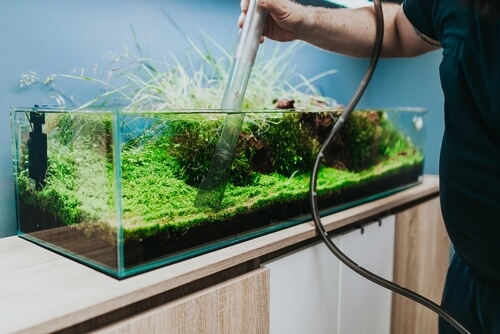
As you will see from our Health Issues Discussed below, many of the common illnesses, stress, and pests that affect Odessa barb are because of a dirty tank that does not have optimal water conditions. Thus, it is crucial to keep your tank well-maintained and clean.
Besides investing in live plants, and other fish species, or snails that help to clean the tank, you still need to do some maintenance and test the water every week.
Ensure that you remove plant matter and food waste immediately and that ornaments and synthetic plants are kept clean. You will also need to do weekly or two weekly water changes;
- Remove at least 25 to 30% of the water from your tank with a suction pipe from the bottom of the tank.
- Prepare the same amount of water in a separate container.
- Add water conditioners and ensure your new water has the right pH and water hardness levels.
- Ensure that the water temperature of the new water and that of the tank are similar, which should be easy enough as Odessa Barbs are cold-water fish.
- Add the newly prepared water to your tank.
Health Issues And Treatment
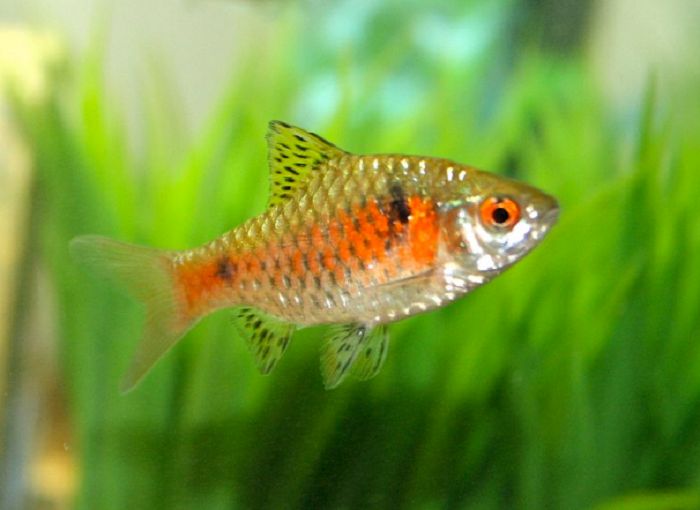
Many of the ailments that affect Odessa barb, being cold water fish, likewise affect Goldfish, so you can follow more in-depth instructions on how to establish and treat these conditions from “Goldfish Behaviour Before Death” on our site. Other than that at this time, these are the common health issues that are specific to Odessa Barbs;
Ich – Also called White Sport disease, which is a parasite causing white spots on the fins and body of the fish. To treat the condition the fish needs to be placed in a separate tank, with optimal water conditions, and you can add some aquarium salts. Change the water in the tank daily for a week to control the life cycle of the parasite. Keep in mind Ich is an infectious parasite that may infect other fish.
Swim Bladder Disease – If you notice that your fish are incapable of remaining in a stable upright position in the water and that they tend to roll, float, sink, or even turn upside down, they most likely have Swim Bladder Disease. The disease is a bacterial infection that affects their “swim bladder” which enables them to stay afloat.
You can quarantine your fish, or simply change the water on the tank. Ensure that you feed your Barb fish shelled peas and daphnia, which can help with digestive issues that may be the cause of the condition. Likewise, the swim bladder can be treated with antibiotics.
Fin Rot – Fin Rot is an infection caused by injuries, on the fins of your Odessa barbs, or it may be from other fish nipping at their fins. Poor water conditions in turn cause the infection. You may notice discoloration such as white edges and red streaks on the parts that have started to rot. It is best to quarantine a fish with Fin Rot and keep the water parameters in an optimal state. Antibacterial treatments can be added to the water to clear up the infection.
Dropsy – Unfortunately this is a very tough disease to deal with, and the chances of the affected fish not surviving are quite considerable. You may notice your fish has lifted scales, and that it is very bloated. The symptoms arise because of a build-up of fluids inside the body cavities and tissues of the fish.
The cause of Dropsy can be instigated by many matters such as stress, poor water conditions, a compromised immune system, poor diet, or sudden water changes. The best option here is to quarantine your fish, and add some Epsom salts to the water, or bathe your fish in Epsom salts. Antibiotics may help, yet only IF the cause is a bacterial infection.
Breeding Your Odessa Barb Fish
Odessa barb are known as egg scatterers and they do not take care of their young. You will need a separate tank that is well conditioned and contains many bushy plants for the eggs to be scattered on, and the young fry to hide among. Odessa Barb reaches sexual maturity at around three to four months of age and will usually only mate with a single partner.
1. Spawning
The male and female will swim to the most planted area of the breeding tank where the female will scatter her eggs and the male will fertilize them. They prefer spawning in the early mornings, and the female releases around 20 eggs at a time with a few batches of up to around 150 eggs. Spawning may take several hours, after which the male and female need to be removed from the tank.
2. Fry Care
The fry will hatch within a day, and become free swimmers as soon as the next day. You can feed the new hatchlings baby brine shrimp as soon as they start swimming freely. Keep them well-fed and in water conditions at peak levels, and they will grow fast and flourish.
In Conclusion
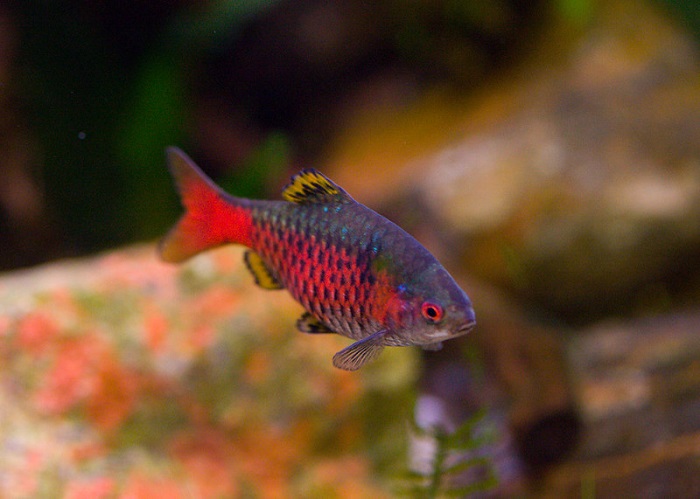
Odessa Barb are hardy and interesting fish to keep as pets, they are quite colorful and active and will keep you well entertained. I do however want to raise a few main points on them before we Conclude;
- They have a short lifespan of 3 to 5 years, and they grow fast.
- They are Schooling fish and must be kept in groups of five or more.
- They are very sensitive to illness and pests, so it’s best to keep water conditions at peak levels.
- They need a varied diet of Plants and proteins.
- Tank mates must be chosen carefully as Odessa Barb requires colder water conditions, and cannot be kept with aggressive and territorial fish.
- They need plenty of plants on the edges of their tank, and plenty of open space in the center for swimming.


